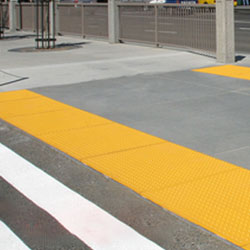









Tactile surfaces such as detectable warning pavers, tiles, and plates serve a vital purpose in enhancing accessibility and navigation for individuals with visual disabilities. The humble beginnings of these textured ground indicators have blossomed into an indispensable infrastructure component that promotes mobility and independence.
In this blog, we'll explore some key milestones in the evolutionary journey of tactile surfaces. Understanding this history provides insight into how these accessible design elements came to transform public spaces.
The genesis of tactile paving traces back to post-World War II Japan. After the war, Japan's cities saw an influx of veterans with visual disabilities. This highlighted the need for urban design features to assist navigation.
In 1965, Seiichi Miyake, an engineering student at Okayama University, developed an innovative solution - textured blocks with raised domes and bars detectable by foot and cane. His invention was inspired by Braille blocks.
In 1965 itself, Miyake's tactile blocks were installed for the first time at a street crossing in Okayama City. This pioneering installation near a school for the blind kickstarted the tactile paving revolution.
Soon after, the textured blocks spread across Japan at pedestrian crossings to promote safety. Their runaway success led to the adoption of national railways across transit platforms nationwide.
By 1985, tactile paving was ubiquitous in Japan. That year, it was formally christened “Hazard Guide for the Visually Impaired.”
Color coding also helped users interpret different blocks. This formalized tactile system accelerated accessible urban growth across Japan.
In the 1990s, tactile paving expanded beyond Japan, becoming recognized internationally as an indispensable tool for accessible design.
The ADA in the US, Australia’s Disability Discrimination Act, and the UK’s Department for Transport helped proliferate tactile paving by setting standards.
By the late 1990s, tactile blocks were ubiquitous across transit platforms and pedestrian walkways in major cities across North America, Europe, and Oceania.
Canada actively adopted tactile systems starting in the 1990s across transportation infrastructure. In the 2000s, integration spread to the wider public realm via provincial and municipal accessibility laws.
The Accessibility for Ontarians with Disabilities Act (AODA) currently mandates tactile installation in all new and renovated public spaces across the province.
Today, tactile paving is entrenched worldwide as an indispensable accessibility solution. With the population aging, chronic illnesses, and mobility device usage increasing, the importance of tactile surfaces grows each year.
Tactile surfaces allow users of all abilities to access outdoor recreation, transit systems, pedestrian routes, businesses, and public services independently and safely.
The evolution of voluntary accessible design into enforceable regulations and standards has helped drive universal adoption. Tactile surfaces now seamlessly blend into urban landscapes as an intuitive accessibility aid.
Tactile solutions like detectable warning tiles and plates are vital in making infrastructure accessible for multiple reasons:
Tactile surfaces allow people with visual disabilities to navigate safely using senses like touch and hearing. The textured cues provide spatial awareness, directionality, and hazard warnings.
Tactile plates transform unfamiliar, complex environments into navigable spaces by providing a mental map. This allows for exploration with confidence, independence, and security.
Tactile patterns placed strategically help users detect and avoid dangers like platform edges, busy intersections, and stairs through tactile feedback.
Installing compliant tactile surfaces satisfies legal obligations under disability legislation like the AODA, ADA, and building codes.
Standardized installation ensures uniformity in how warnings and cues are conveyed across regions. This consistency enables intuitive interpretation.
By facilitating accessible navigation, tactile surfaces encourage fuller participation in community life, from parks to libraries to arenas.
In Canada, tactile installations must adhere to accessibility legislation and standards. Key regulations include:
Accessibility for Ontarians with Disabilities Act (AODA)
Thanks to inclusive design advocacy, rigorous testing, and human-centered innovation, tactile surfaces have evolved into an indispensable component of accessibility.
Ongoing research aims to enhance detectability and aesthetics using technologies like RFID-embedded and LED-integrated tiles. As populations age and diversify, the need for accessible infrastructure only grows.
Tactile wayfinding and hazard warning solutions continue advancing in lockstep with progressive social values of equity, mobility, and independence.
The future looks bright for tactile surfaces to play an ever-greater role in crafting barrier-free, welcoming communities that leave no one behind. The universal adoption of these inclusive design elements is a mark of societies progressing towards accessibility for all citizens.
Tactile paving was invented in 1965 by Japanese engineering student Seiichi Miyake, who was inspired by Braille.
The first ever use of tactile paving was in 1965 at a street crossing in Okayama City, Japan, near a school for the blind.
Tactile paving was introduced in North America in the 1990s after the ADA and Disability Discrimination Act set detectable warning standards.
Common tactile paving materials are durable polymers, metals, porcelain, rubber, concrete, and engineered composite plastics.
Tactile surfaces provide standardized tactile and audio cues to help visually impaired pedestrians detect hazards, navigate safely, avoid disorientation, and travel independently.
As Canada's leading tactile solutions provider, Tactile Solutions Canada offers premium products to make infrastructure accessible. Our extensive range includes:
Let our team of experts recommend optimal solutions for your next public space project. Contact Tactile Solutions Canada today!
